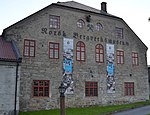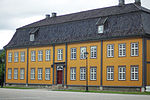Kongsberg

Kongsberg (Norwegian pronunciation: [ˈkɔ̂ŋːsbær(ɡ)] ) is a historical mining town and municipality in Buskerud county, Norway. The city is located on the river Numedalslågen at the entrance to the valley of Numedal. Kongsberg has been a centre of silver mining, arms production and forestry for centuries, and is the site of high technology industry including the headquarters of Norway's largest defence contractor Kongsberg Gruppen. Kongsberg, formerly spelled Konningsberg (lit. "King's Mountain"), was developed as a mining city on the basis of the Kongsberg Silver Mines, founded by and named after King Christian IV of Denmark and Norway in 1624. The king invited German engineers and other specialists from Saxony and the Harz region to help build the mining company. As a mining city, Kongsberg had a distinct urban culture that contrasted with its surroundings, strongly influenced by the traditions of mining communities in Germany and where the German language was extensively used in mining business and for religious services. In the first years nearly half of the city's population were German immigrants, and the majority of the engineers and executives were German immigrants and their descendants well into the 19th century, becoming a distinct social class called mining families that formed the educated social elite of Kongsberg in contrast to the Norwegian farming population; the first Nobel laureate in economics Ragnar Frisch belonged to such a Kongsberg mining family. By the 18th century Kongsberg was Norway's second largest city, second only to Bergen. Kongsberg was one of Norway's two privileged mining cities and thus formed a special mining jurisdiction (Norwegian: Bergstad), and only became part of Buskerud county in 1760. On 1 January 1838, the new national law, creating local governments, made Kongsberg a municipality. The rural municipalities of Ytre Sandsvær and Øvre Sandsvær were merged into the municipality of Kongsberg in 1964. Kongsberg gradually lost importance to other cities in the 19th century, particularly to the rapidly growing capital of Christiania (Oslo). The Kongsberg Silver Mines closed in 1958 after operating for 334 years and is today a museum and the city's main tourist attraction. Kongsberg remains the site of the Royal Norwegian Mint (Norwegian: Det Norske Myntverket), which mints Norwegian coins and also produces circulating and collectors' coins for other countries. Kongsberg is also the home of Norway's major defence contractor, Kongsberg Gruppen, founded in 1814. Two of its best-known products were the Kongsberg Colt and the Krag–Jørgensen rifle.Both the University of South-Eastern Norway Kongsberg campus, and Tinius Olsen's school, a combined technical vocational college and secondary school, are located in Kongsberg.
Excerpt from the Wikipedia article Kongsberg (License: CC BY-SA 3.0, Authors, Images).Kongsberg
Avenue du Général de Gaulle, Mülhausen
Geographical coordinates (GPS) Address Nearby Places Show on map
Geographical coordinates (GPS)
| Latitude | Longitude |
|---|---|
| N 59.669444444444 ° | E 9.6516666666667 ° |
Address
Avenue du Général de Gaulle 45
68170 Mülhausen
Grand Est, Frankreich
Open on Google Maps







